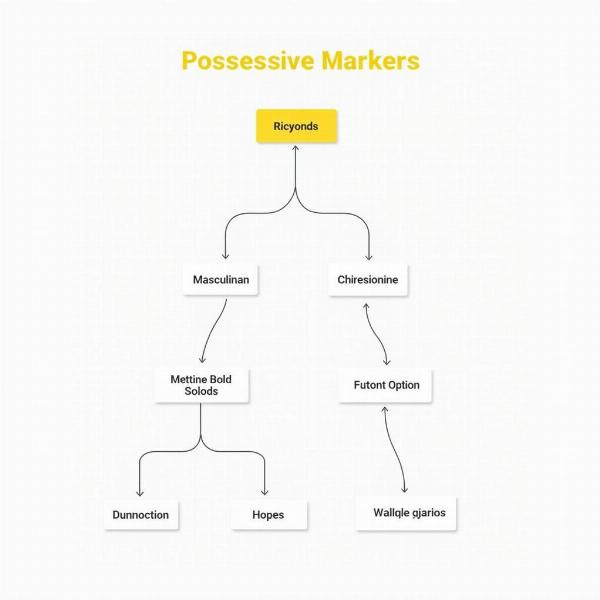Understanding the concept of “possessive” and its various expressions in Hindi is crucial for anyone learning the language. Whether you’re trying to express ownership, belonging, or relationships, knowing how to convey possessiveness accurately is essential for effective communication. This guide explores the different ways to express “possessive in Hindi meaning,” from basic pronouns to more nuanced grammatical structures.
Understanding Possessive Pronouns in Hindi
Possessive pronouns in Hindi, like their English counterparts, indicate ownership or belonging. They change based on the gender and number of the noun they modify. Let’s examine some common possessive pronouns:
- मेरा (mera) – my (masculine singular): Used with masculine singular nouns. Example: मेरा घर (mera ghar) – my house.
- मेरी (meri) – my (feminine singular): Used with feminine singular nouns. Example: मेरी किताब (meri kitaab) – my book.
- मेरे (mere) – my (masculine plural): Used with masculine plural nouns and respectful singular. Example: मेरे भाई (mere bhai) – my brothers.
- तुम्हारा (tumhara) – your (masculine singular, informal): Used when addressing someone informally.
- तुम्हारी (tumhari) – your (feminine singular, informal): Used when addressing someone informally.
- आपका (aap ka) – your (masculine singular, formal): Used to address someone respectfully.
The Possessive Case Marker का/की/के (ka/ki/ke)
The postpositions का (ka), की (ki), and के (ke) are crucial for indicating possession. They function similarly to the English apostrophe + s (‘s). The form used depends on the gender and number of the noun being possessed:
- का (ka): Used with masculine singular nouns. Example: राम का घर (Ram ka ghar) – Ram’s house.
- की (ki): Used with feminine singular and plural nouns. Example: सीता की किताब (Sita ki kitaab) – Sita’s book.
- के (ke): Used with masculine plural nouns. Example: लड़कों के खिलौने (ladkon ke khilone) – the boys’ toys.
 Possessive Case Markers in Hindi
Possessive Case Markers in Hindi
Expressing Possessiveness with the Genitive Case
The genitive case in Hindi combines the possessive pronoun with the case marker (ka/ki/ke). This further emphasizes possession and creates a stronger link between the possessor and the possessed object. For instance, मेरा घर (mera ghar) becomes मेरे घर का (mere ghar ka) when followed by another noun related to the house, as in मेरे घर का बगीचा (mere ghar ka bagicha – my house’s garden). This structure is particularly important when talking about relationships or attributes of the possessed item.
Possessive Adjectives in Hindi
Possessive adjectives, although similar to possessive pronouns, function differently. They directly modify nouns without needing the case markers (ka/ki/ke). Examples include अपना (apna – one’s own), पराया (paraya – someone else’s).
How to Say “He is very possessive” in Hindi
Translating “He is very possessive” into Hindi requires capturing the nuance of the English phrase. A common translation would be वह बहुत अधिकारवादी है (wah bahut adhikarwadi hai), using अधिकारवादी (adhikarwadi) which signifies “authoritarian” or “controlling,” thus conveying the sense of possessiveness. Alternatively, one might say वह बहुत ज़िद्दी है (wah bahut ziddi hai) meaning “He is very stubborn” or वह बहुत चिपकू है (wah bahut chipku hai) meaning “He is very clingy” depending on the context.
Conclusion: Mastering Possessiveness in Hindi
Understanding “possessive in Hindi meaning” involves mastering the interplay of possessive pronouns, case markers, and the genitive case. By studying these elements and practicing their usage, you can confidently express ownership and belonging in Hindi, enriching your communication and deepening your understanding of the language.
FAQ:
- What is the difference between मेरा (mera) and मेरी (meri)? मेरा (mera) is used with masculine singular nouns, while मेरी (meri) is used with feminine singular nouns.
- When do I use के (ke) instead of का (ka) or की (ki)? के (ke) is used with masculine plural nouns.
- How do I say “my father’s car” in Hindi? You would say मेरे पिता की गाड़ी (mere pita ki gaadi).
- What is the meaning of अपना (apna)? अपना (apna) means “one’s own.”
- How can I express different levels of possessiveness in Hindi? You can use adverbs like बहुत (bahut – very) or ज़्यादा (zyada – more) along with possessive adjectives and pronouns.
Meaning-Hindi.in is your one-stop solution for all your Hindi translation needs. We offer a wide range of services, from business and legal document translation to website localization and technical translation. Our team of expert Hindi linguists ensures accurate and culturally sensitive translations. Contact us today at [email protected] or +91 11-4502-7584 to discuss your project requirements. Meaning-Hindi.in helps bridge the language gap for seamless communication.